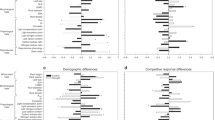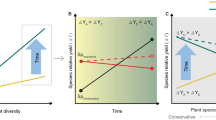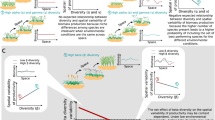Abstract
The way species avoid each other in a community by using resources differently across space and time is one of the main drivers of species coexistence in nature1,2. This mechanism, known as niche differentiation, has been widely examined theoretically but still lacks thorough experimental validation in plants. To shape niche differences over time, species within communities can reduce the overlap between their niches or find unexploited environmental space3. Selection and phenotypic plasticity have been advanced as two candidate processes driving niche differentiation4,5, but their respective role remains to be quantified6. Here, we tracked changes in plant height, as a candidate trait for light capture7, in 5-year multispecies sown grasslands. We found increasing among-species height differences over time. Phenotypic plasticity promotes this change, which explains the rapid setting of differentiation in our system. Through the inspection of changes in genetic structure, we also highlighted the contribution of selection. Altogether, we experimentally demonstrated the occurrence of species niche differentiation within artificial grassland communities over a short time scale through the joined action of both plasticity and selection.
This is a preview of subscription content, access via your institution
Access options
Access Nature and 54 other Nature Portfolio journals
Get Nature+, our best-value online-access subscription
$29.99 / 30 days
cancel any time
Subscribe to this journal
Receive 12 digital issues and online access to articles
$119.00 per year
only $9.92 per issue
Buy this article
- Purchase on Springer Link
- Instant access to full article PDF
Prices may be subject to local taxes which are calculated during checkout



Similar content being viewed by others
Data availability
The data that support the findings of this study are available at https://data.inra.fr/privateurl.xhtml?token=8bcba8cf-56b6-4210-89d5-9beca09801b7.
References
Levine, J. M. & HilleRisLambers, J. The importance of niches for the maintenance of species diversity. Nature 461, 254–257 (2009).
Chesson, P. Mechanisms of maintenance of species diversity. Annu. Rev. Ecol. Syst. 31, 343–366 (2000).
Von Felten, S. et al. Belowground nitrogen partitioning in experimental grassland plant communities of varying species richness. Ecology 90, 1389–1399 (2009).
Roscher, C., Schumacher, J., Schmid, B. & Schulze, E. D. Contrasting effects of intraspecific trait variation on trait-based niches and performance of legumes in plant mixtures. PLoS ONE 10, e0119786 (2015).
Vellend, M. The consequences of genetic diversity in competitive communities. Ecology 87, 304–311 (2006).
Niklaus, P. A., Baruffol, M., He, J. S., Ma, K. P. & Schmid, B. Can niche plasticity promote biodiversity–productivity relationships through increased complementarity? Ecology 98, 1104–1116 (2017).
Westoby, M. A leaf–height–seed (LHS) plant ecology strategy scheme. Plant Soil 199, 213–227 (1998).
Turnbull, L. A., Levine, J. M., Loreau, M. & Hector, A. Coexistence, niches and biodiversity effects on ecosystem functioning. Ecol. Lett. 16, 116–127 (2013).
Cardinale, B. J. et al. Impacts of plant diversity on biomass production increase through time because of species complementarity. Proc. Natl Acad. Sci. USA 104, 18123–18128 (2007).
Tilman, D., Isbell, F. & Cowles, J. M. Biodiversity and ecosystem functioning. Annu. Rev. Ecol. Evol. System. 45, 471–493 (2014).
Navas, M. L. & Violle, C. Plant traits related to competition: how do they shape the functional diversity of communities? Commun. Ecol. 10, 131–137 (2009).
D’Andrea, R. & Ostling, A. Challenges in linking trait patterns to niche differentiation. Oikos 125, 1369–1385 (2016).
Roughgarden, J. Resource partitioning among competing species—a coevolutionary approach. Theor. Popul. Biol. 9, 388–424 (1976).
Loreau, M. & de Mazancourt, C. Biodiversity and ecosystem stability: a synthesis of underlying mechanisms. Ecol. Lett. 16, 106–115 (2013).
Hart, S. P., Schreiber, S. J. & Levine, J. M. How variation between individuals affects species coexistence. Ecol. Lett. 19, 825–838 (2016).
Schoener, T. W. Resource partitioning in ecological communities. Science 185, 27–39 (1974).
Scheele, B. C., Foster, C. N., Banks, S. C. & Lindenmayer, D. B. Niche contractions in declining species: mechanisms and consequences. Trends Ecol. Evol. 32, 346–355 (2017).
Berg, M. P. & Ellers, J. Trait plasticity in species interactions: a driving force of community dynamics. Evol. Ecol. 24, 617–629 (2010).
Grenier, S., Barre, P. & Litrico, I. Phenotypic plasticity and selection: nonexclusive mechanisms of adaptation. Scientifica 2016, 7021701 (2016).
Zuppinger-Dingley, D. et al. Selection for niche differentiation in plant communities increases biodiversity effects. Nature 515, 108–111 (2014).
Van Moorsel, S. J. et al. Community evolution increases plant productivity at low diversity. Ecol. Lett. 21, 128–137 (2018).
Meilhac, J., Durand, J. L., Beguier, V. & Litrico, I. Increasing the benefits of species diversity in multispecies temporary grasslands by increasing within-species diversity. Ann. Bot. 123, 891–900 (2019).
Gautier, H., Varlet-Grancher, C. & Baudry, N. Comparison of horizontal spread of white clover (Trifolium repens L.) grown under two artificial light sources differing in their content of blue light. Ann. Bot. 82, 41–48 (1998).
Roscher, C., Kutsch, W. L. & Schulze, E. D. Light and nitrogen competition limit Lolium perenne in experimental grasslands of increasing plant diversity. Plant Biol. 13, 134–144 (2011).
McGill, B. J., Enquist, B. J., Weiher, E. & Westoby, M. Rebuilding community ecology from functional traits. Trends Ecol. Evol. 21, 178–185 (2006).
Violle, C. & Jiang, L. Towards a trait-based quantification of species niche. J. Plant Ecol. 2, 87–93 (2009).
Gommers, C. M. M., Visser, E. J. W., St Onge, K. R., Voesenek, L. & Pierik, R. Shade tolerance: when growing tall is not an option. Trends Plant Sci. 18, 65–71 (2013).
Pontes, L. D., Maire, V., Louault, F., Soussana, J. F. & Carrere, P. Impacts of species interactions on grass community productivity under contrasting management regimes. Oecologia 168, 761–771 (2012).
Schippers, P. & Kropff, M. J. Competition for light and nitrogen among grassland species: a simulation analysis. Funct. Ecol. 15, 155–164 (2001).
Weiner, J. & Thomas, S. C. Size variability and competition in plant monocultures. Oikos 47, 211–222 (1986).
Falster, D. S. & Westoby, M. Plant height and evolutionary games. Trends Ecol. Evol. 18, 337–343 (2003).
Bittebiere, A. K., Saiz, H. & Mony, C. New insights from multidimensional trait space responses to competition in two clonal plant species. Funct. Ecol. 33, 297–307 (2019).
Maire, V. et al. Disentangling coordination among functional traits using an individual-centred model: impact on plant performance at intra- and inter-specific levels. PLoS ONE 8, e77372 (2013).
Nelson, C. J. in Grassland Ecophysiology and Grazing Ecology 101–126 (Univ. Press Cambridge, 2000).
Maire, V. et al. Habitat filtering and niche differentiation jointly explain species relative abundance within grassland communities along fertility and disturbance gradients. New Phytol. 196, 497–509 (2012).
Adler, P. B., Fajardo, A., Kleinhesselink, A. R. & Kraft, N. J. B. Trait-based tests of coexistence mechanisms. Ecol. Lett. 16, 1294–1306 (2013).
Marriott, C. A., Bolton, G. R. & Duff, E. I. Factors affecting the stolon growth of white clover in ryegrass/clover patches. Grass Forage Sci. 52, 147–155 (1997).
Turcotte, M. M. & Levine, J. M. Phenotypic plasticity and species coexistence. Trends Ecol. Evol. 31, 803–813 (2016).
McPeek, M. A. The ecological dynamics of natural selection: traits and the coevolution of community structure. Am. Nat. 189, E91–E117 (2017).
Chacón-Labella, J., García Palacios, P., Matesanz, S., Schöb, C. & Milla, R. Plant domestication disrupts biodiversity effects across major crop types. Ecol. Lett. 22, 1472–1482 (2019).
Vos, P. et al. AFLP: a new technique for DNA fingerprinting. Nucleic Acids Res. 23, 4407–4414 (1995).
Piry, S. et al. GENECLASS2: a software for genetic assignment and first-generation migrant detection. J. Hered. 95, 536–539 (2004).
Rannala, B. & Mountain, J. L. Detecting immigration by using multilocus genotypes. Proc. Natl Acad. Sci. USA 94, 9197–9201 (1997).
Nei, M., Tajima, F. & Tateno, Y. Accuracy of estimated phylogenetic trees from molecular data. J. Mol. Evol. 19, 153–170 (1983).
Pritchard, J. K., Stephens, M. & Donnelly, P. Inference of population structure using multilocus genotype data. Genetics 155, 945–959 (2000).
Falush, D., Stephens, M. & Pritchard, J. K. Inference of population structure using multilocus genotype data: dominant markers and null alleles. Mol. Ecol. Notes 7, 574–578 (2007).
Jakobsson, M. & Rosenberg, N. A. CLUMPP: a cluster matching and permutation program for dealing with label switching and multimodality in analysis of population structure. Bioinformatics 23, 1801–1806 (2007).
Gelman, A., Hwang, J. & Vehtari, A. Understanding predictive information criteria for Bayesian models. Stat. Comput. 24, 997–1016 (2014).
Acknowledgements
The authors thank V. Beguier, head of research at the Jouffray Drillaud Company (Saint Sauvant, France), and his technical team for installation of the experiment, the URP3F technical team, and particularly D. Dénoue and B. Bonneau who provided important experimental assistance. The Agence Nationale de la Recherche in France (PRAISE; ANR-13-ADAP-0015) funded this work. The PhD salary of J.M. was supported by the Poitou-Charentes region and INRA (BAP division and MP EcoServ). V.M. and L.D. were supported by the Natural Sciences and Engineering Research Council of Canada (NSERC-Discovery-2016-05716).
Author information
Authors and Affiliations
Contributions
I.L. initiated the research question, obtained the funds and led the working group. I.L., J.M. and S.F. collected the data. J.M. and S.F. organized the dataset. All authors coordinated the analyses. J.M., I.L., V.M. and L.D. drafted the manuscript. All authors contributed to the final manuscript.
Corresponding author
Ethics declarations
Competing interests
The authors declare that they have no competing interests.
Additional information
Peer review information Nature Plants thanks Bernhard Schmid and the other, anonymous, reviewers for their contribution to the peer review of this work.
Publisher’s note Springer Nature remains neutral with regard to jurisdictional claims in published maps and institutional affiliations.
Supplementary information
Supplementary Information
Supplementary Figs. 1–13 and Supplementary Notes.
Supplementary Tables
Supplementary Tables 1–6.
Source data
Source Data Fig. 1
Height data source.
Source Data Fig. 2
Data source of Height and cultivar frequencies.
Source Data Fig. 3
Biomass data source.
Rights and permissions
About this article
Cite this article
Meilhac, J., Deschamps, L., Maire, V. et al. Both selection and plasticity drive niche differentiation in experimental grasslands. Nat. Plants 6, 28–33 (2020). https://doi.org/10.1038/s41477-019-0569-7
Received:
Accepted:
Published:
Issue Date:
DOI: https://doi.org/10.1038/s41477-019-0569-7
This article is cited by
-
A research agenda for scaling up agroecology in European countries
Agronomy for Sustainable Development (2022)
-
Pesticide-free agriculture as a new paradigm for research
Agronomy for Sustainable Development (2022)



